The main regions in the largely agrarian state with less than 2 percent of the country’s population are Bagar, Bangar, Deswali, Ahirwal, Mewat, Braj, Khedar and Nardak.
While unemployment and the unresolved farmers’ protests are common election issues across the state, regional identities will also determine how people vote in Haryana where a resurgent Congress is widely expected to win.
Experts say each region is often also defined by a dominant community or clan.
Mahabir Jaglan, a political analyst and retired professor of geography at Kurukshetra University, told ThePrint that Jats dominated the Bagar, Bangar and Deswali regions and have been voting for their regional leaders at different times.
“Devi Lal had once become an undisputed leader of the community cutting across the regional divide between 1982 and 1989 before his son, Om Prakash Chautala, lost the Deswali belt to Bhupinder Singh Hooda in 1990,” Jaglan said.
“The Jats in Haryana are divided into two—Deswali and Bagri (Bagar)—depending on when they came to settle in Haryana. Those who came from Rajasthan some 300 years ago are settled in the Bagri area and are known as Bagri Jats. Those who have lived here for more than 500 to 600 years are Deswalis, and are largely settled in the Deshwal area,” said Jaglan.
He added that Jats from the two regions are culturally different with khaps being more influential in the Deswali area while Bagri Jats don’t have any khaps.
Also Read: OBCs, Jats, Muslims: How caste equations figure in BJP, Congress ticket distribution in Haryana
Bagar belt
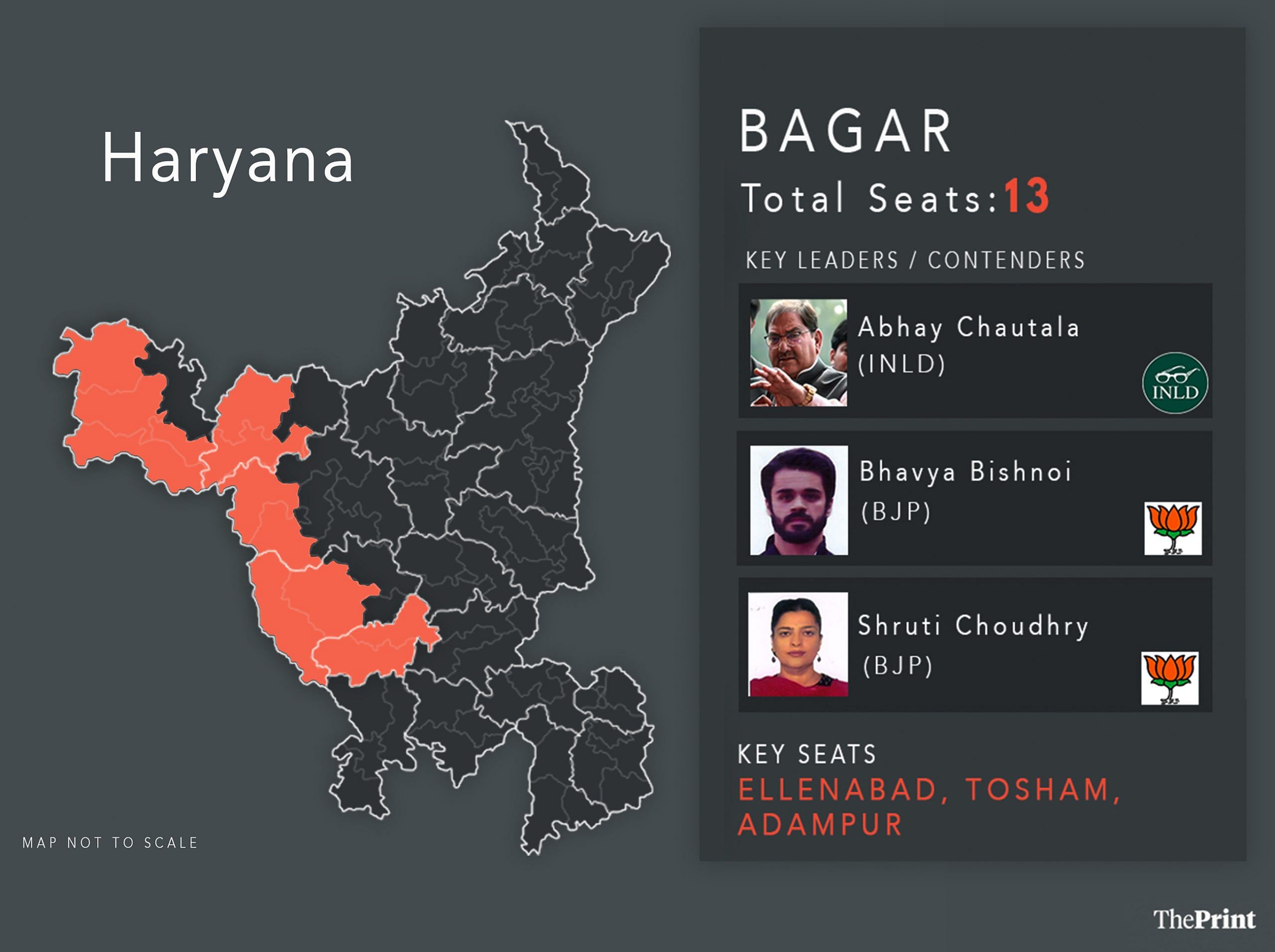
One of the most politically prominent areas is Bagar in the southwestern part of Haryana, which has given six of the state’s 11 chief ministers since the state was created in 1966. Bansi Lal, Banarsi Dass Gupta, Devi Lal, Bhajan Lal, Om Prakash Chautala and Hukum Singh came from the Bagar region.
Nearly 13 crucial assembly seats are located in the Bagar belt’s Bhiwani and Charkhi Dadri areas as well as parts of Hisar, Sirsa, and Fatehabad.
Bagri Jats dominate most of the region while Bishnois, also an offshoot of Jats, live in parts of the Sirsa, Hisar and Fatehabad districts.
Historically, Bansi Lal’s clan had a strong influence over Bagar seats falling in the Bhiwani area, including the present Charkhi Dadri district, until 1996. And Devi Lal’s Indian National Lok Dal (INLD) held sway over Bagar seats in Sirsa, Fatehabad and Hisar until the INLD split in 2018.
After the Bansi Lal era, his clan was restricted to the Tosham seat alone while the Chautalas enjoyed support in Bhiwani and Charkhi Dadri districts until the INLD split. Even in 2019, Dushyant Chautala’s mother, Naina Chautala, was elected from the region’s Badhra seat.
Prominent faces from the Bagar region contesting the polls include eight members of Devi Lal’s clan including Aditya Devi Lal, Digvijay Chautala and Amit Sihag from Dabwali; Abhay Chautala’s son Arjun Chautala and Devi Lal’s son Ranjit Singh from Rania; and Abhay Chautala from Ellenabad.
Former chief minister Bhajan Lal’s grandson Bhavya Bishnoi, Haryana agriculture minister J.P. Dalal from Loharu, Bansi Lal’s grand-daughter Shruti Choudhry and grandson Anirudh Choudhary from Tosham are some other prominent faces in the Bagar region.
The Bagar belt is traditionally a dry, semi-arid area with a rich history of animal husbandry. Agriculture—especially mustard, cotton and millet farming—was once more prominent in this region. However, after the advent of the Bhakra canal system and improved irrigation, farmers also sow paddy, wheat, and other crops.
Bagar is a dialect closely related to Haryanvi and Rajasthani.
Bangar belt
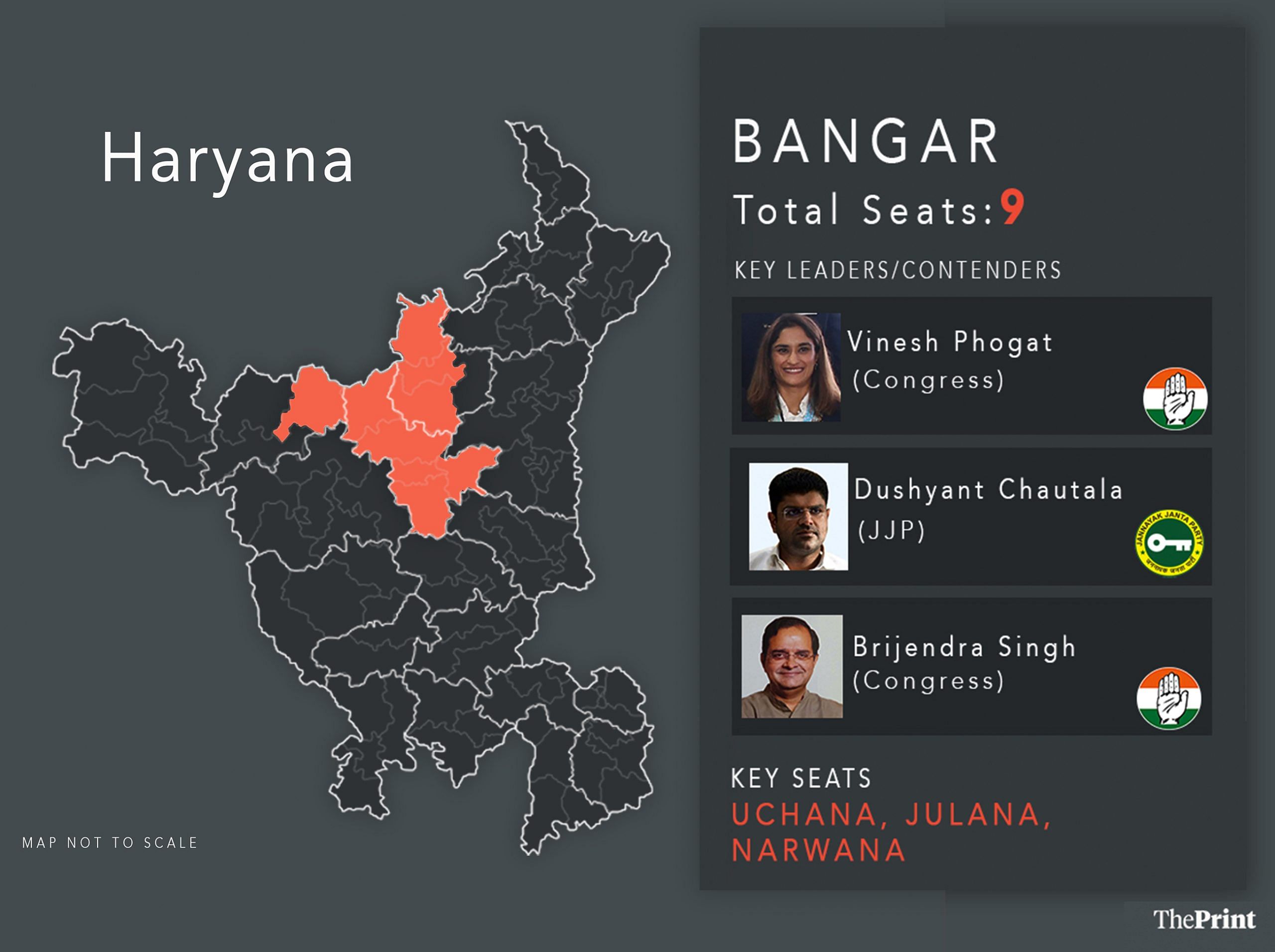
Bangar—which literally means areas beyond the floodplains—has also sent its fair share of high-profile leaders to the Haryana assembly.
Among the prominent leaders from its nine assembly seats spread across the Jind and Kaithal districts are Jat leader Chaudhary Birender Singh from Uchana, Shamsher Singh Surjewala and his son, Randeep Surjewala, who contested from Narwana until the constituency was reserved in 2009 and the family shifted its base to Kaithal. Wrestler Vinesh Phogat’s Julana assembly seat also falls in the Bangar belt.
Despite the influence of Birender Singh and the Surjewalas, the Chautala clan also enjoyed immense support in this region and its members have defeated both families on multiple occasions.
In 2019, Dushyant Chautala’s JJP won six seats in Bangar’s Jat-dominated areas.
Even in the Julana seat from where Vinesh Phogat is contesting, the Chautala family’s parties have won seven out of 11 elections since 1972, Bansi Lal’s Haryana Vikas Party once and the Congress three times.
The region is less fertile as its soil is sandier and it’s less prone to flooding.
Deswali belt
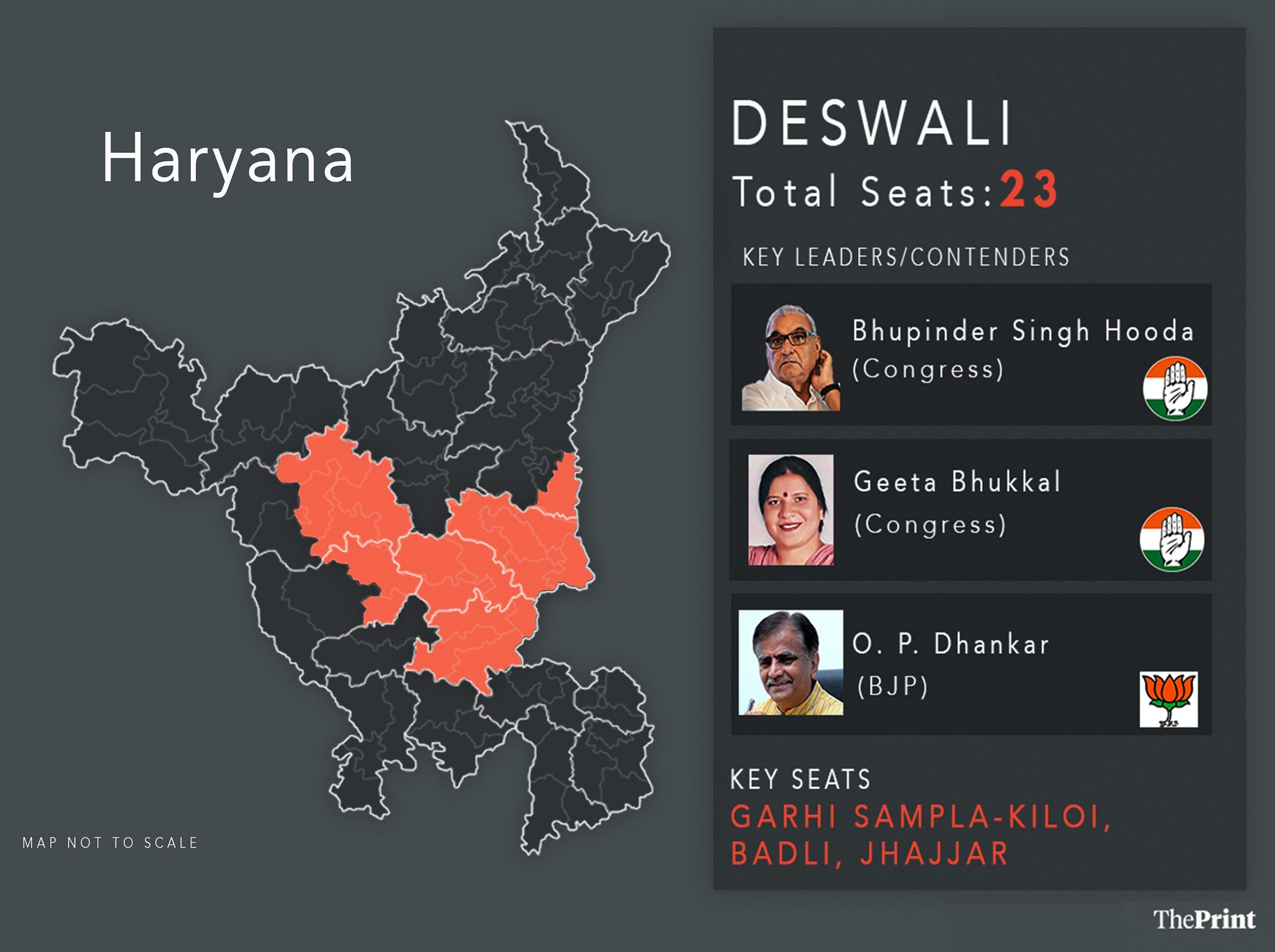
The predominantly agricultural Deswali belt in central Haryana is called the Jat heartland of Haryana and is also considered the heart of traditional Haryanvi culture.
Deswali is a politically significant region with 23 assembly seats falling in the belt which covers parts of districts like Rohtak, Jhajjar, Sonipat and Jind and some parts of Hisar and Panipat.
Former deputy prime minister Devi Lal enjoyed huge support in the Deswali region until violence during a byelection at Meham contested by the then chief minister Om Prakash Chautala resulted in the deaths of 10 people. Since then, former chief minister Bhupinder Singh Hooda has become the undisputed leader of the Deswali belt.
Apart from Bhupinder Singh Hooda from Garhi Sampla-Kiloi, other prominent contestants are the BJP’s national secretary O. P. Dhankar from Badli, former assembly Speaker Raghubir Kadian from Beri, and former Indian kabbadi captain Deepak Hooda of the BJP from Meham.
The Deswali region has strong village-based social structures and a reverence for khap panchayats. Haryanvi, specifically the Deswali dialect, is widely spoken here, and wit and humour are a part of the conversation of local people.
Agriculture is the primary occupation, with wheat, rice and sugarcane being the dominant crops. The region is also known for its role in socio-political movements and the Arya Samaj has strong roots in this region.
Khadar belt
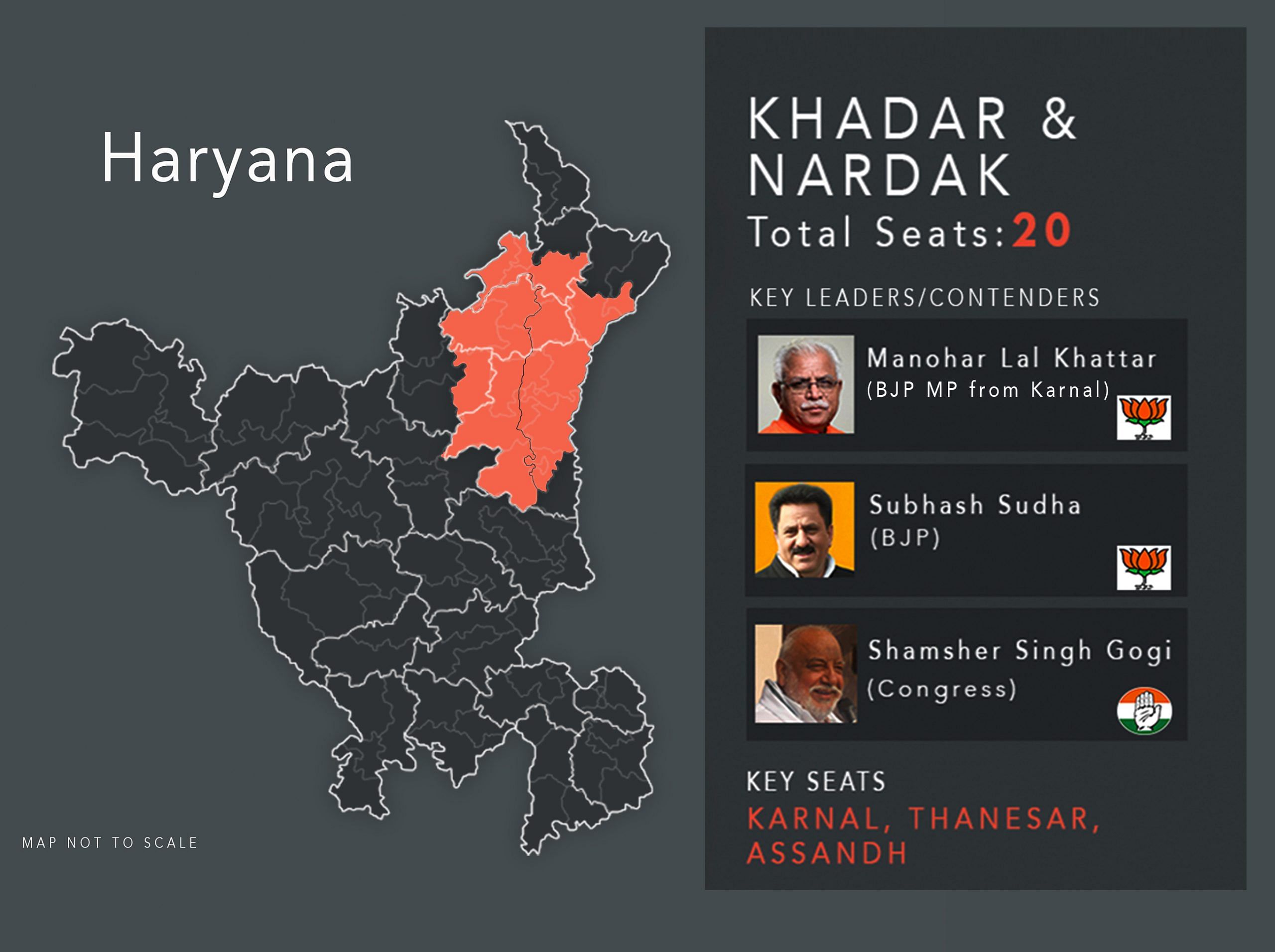
Khadar has never been at the centre of politics in Haryana as chief ministers have mostly been from the Bagar and Deswali regions.
However, this time, all eyes are also on the Khadar belt’s Ladwa constituency where Chief Minister Nayab Saini is fighting a high stakes battle. Former Chief Minister Manohar Lal Khattar’s Karnal constituency also falls in this region.
The Khadar belt—which lies along the Yamuna river—has a mix of OBCs, Punjabis, Kambojs, Sainis, Sikhs, Agarwals and Rors.
Khadar, also known as Khadir or low-lying floodplain, includes parts of districts like Yamunanagar, Karnal and Panipat.
Apart from the cultivation of sugarcane, rice and wheat, the presence of major historical and industrial centres like Panipat also makes it economically significant.
Also read: 3 mighty Lals shaped Haryana politics for decades. How BJP has co-opted their descendants
Nardak belt
Like Khadar, the Nardak area hasn’t been a high-profile political region.
The belt in central and northern Haryana primarily covers districts in parts of Karnal and Kurukshetra.
One of the most prosperous agricultural regions in Haryana known for its highly fertile soil, it also has deep associations with the ancient history of the Mahabharata.
Together, the Khadar and Nardak regions account for more than 20 assembly seats.
Ahirwal region
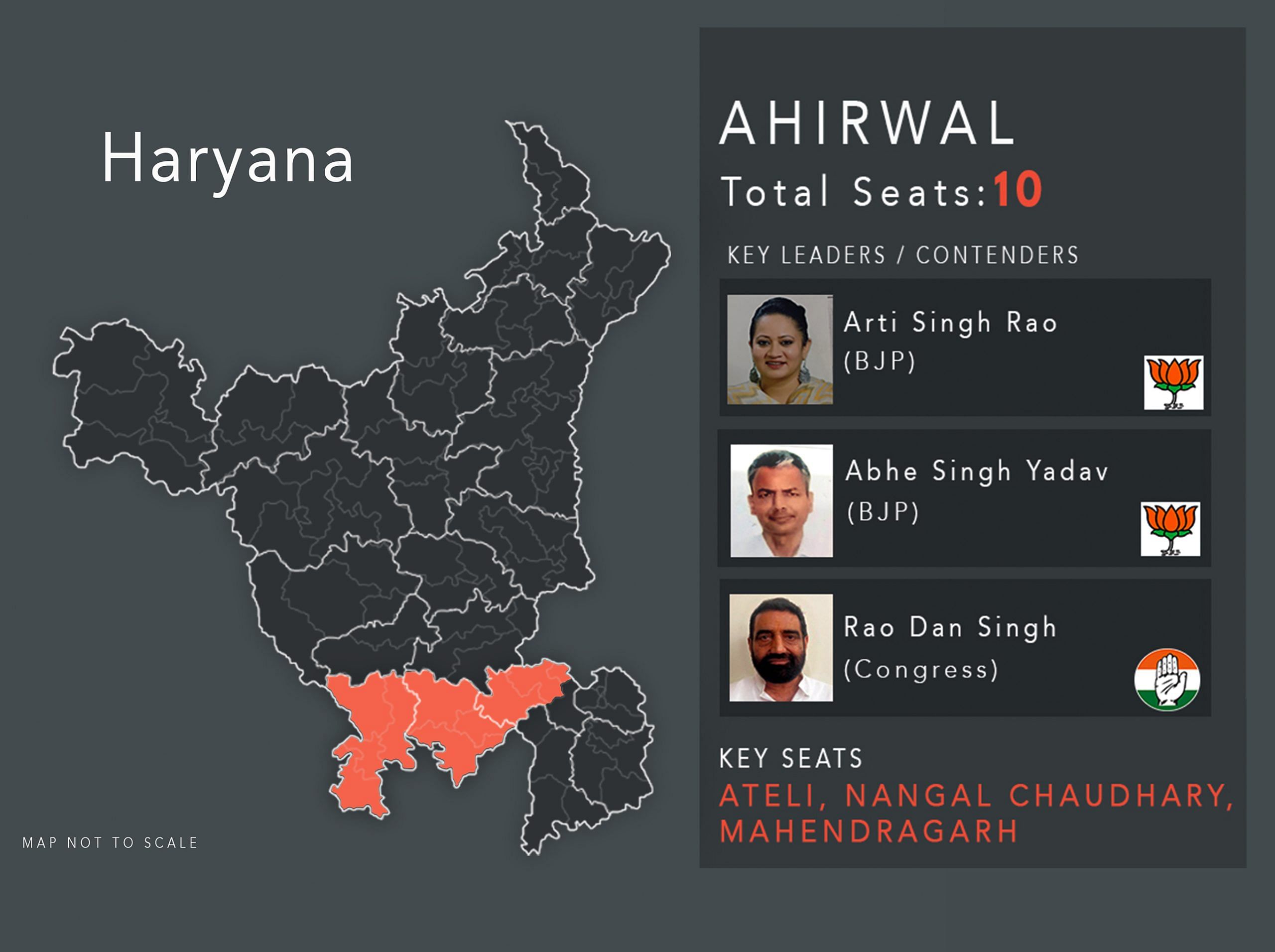
The Ahirwal region has often been in the spotlight because of its proximity to Delhi and Gurugram.
Southern Haryana—including parts of districts like Rewari and Mahendragarh, and the southern portions of Gurugram—comes under the Yadav-dominated Ahirwal region which accounts for 10 assembly seats.
Historically, the clans of former Haryana chief minister Rao Birender Singh and Rao Abhay Singh have reigned over the region’s politics. Rao Birender Singh’s son Rao Inderjit Singh is a Union Minister, while Rao Inderjit’s daughter Arti Rao is contesting from the Ateli assembly seat of Mahendragarh.
Rao Abhay Singh’s grandson, Chiranjeev Rao (former Bihar chief minister Lalu Prasad Yadav’s son-in-law), is contesting as the Congress candidate from Rewari. Another next-generation politician—Rao Mohar Singh’s grandson Rao Narbir Singh—is contesting from Badshahpur.
In 2014, the BJP won all 11 seats in Rewari, Mahendragarh and Gurugram that come under Ahirwal while in 2019, the BJP got eight, the Congress two and Independents one.
This semi-arid region is predominantly inhabited by the Ahir, or Yadav community, from which the name ‘Ahirwal’ is derived. It has historically been associated with animal husbandry and has a strong martial tradition, with many people serving in the armed forces.
The local dialect is Ahirwati, a variant of Haryanvi with some influences from neighbouring Rajasthan.
Mewat or Meo region
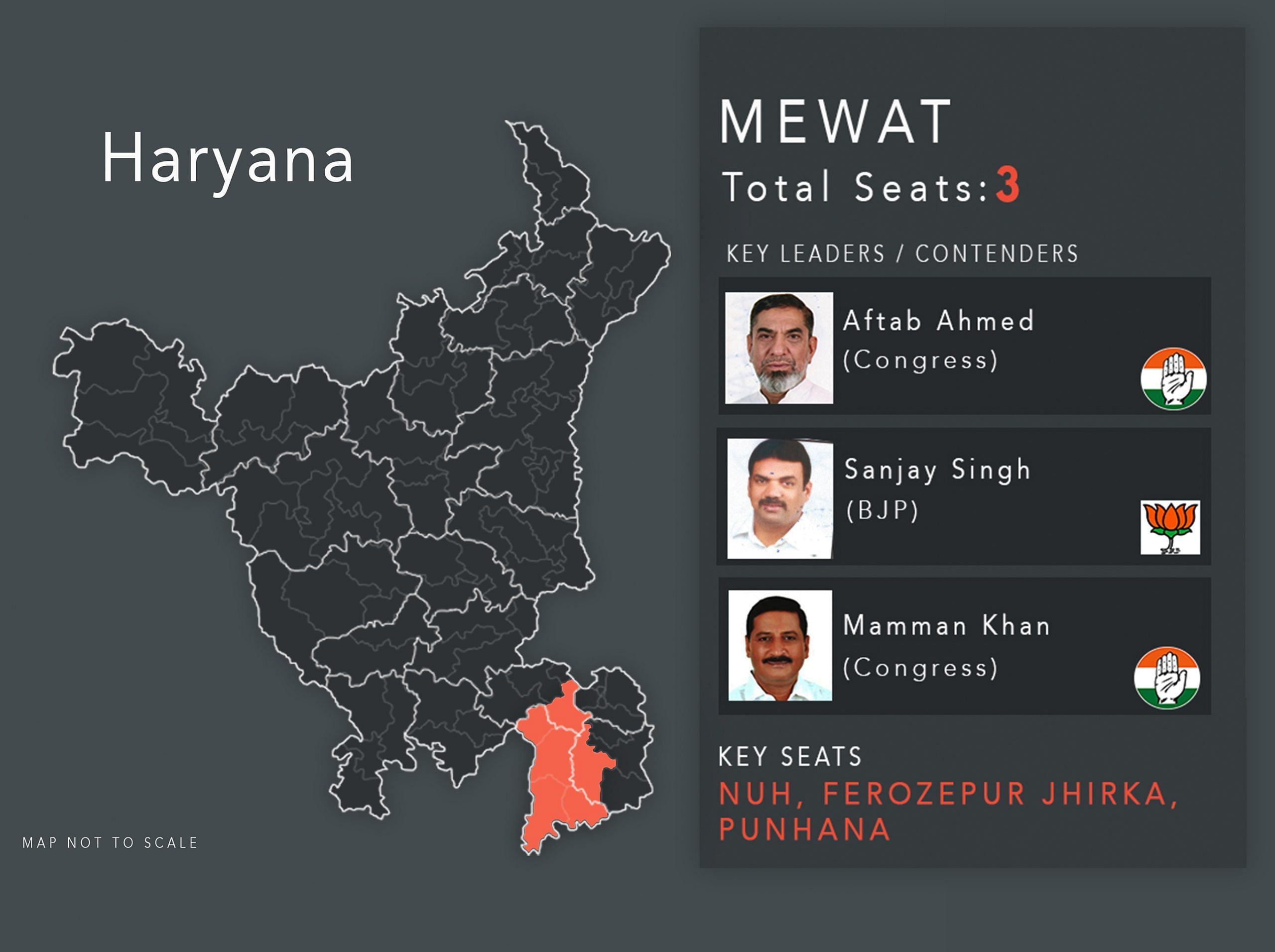
The Mewat region in southeastern Haryana is predominantly inhabited by the Meo Muslim community who have a distinct culture and traditions rooted in both Rajput and Muslim heritage.
The historically marginalised Mewat belt includes the under-developed district of Nuh (formerly Mewat), and parts of Palwal and Faridabad.
Besides the three assembly seats of Nuh district—Nuh, Ferozepur Jhirka and Punhana—the constituencies of Palwal’s Hathin, Gurugram’s Sohna and Faridabad NIT also have a Meo population.
Meo Muslims traditionally don’t vote for the BJP. In 2019, all three seats in Nuh district went to the Congress, while two other seats with a mixed population in Gurugram—Sohna and Palwal (Hathin)—went to the BJP. In 2014, three Meo seats went to Chautala’s INLD.
Two political families headed in the past by Tayyab Hussain and Khursheed Ahmad had a lot of influence on Mewat’s politics. Now, their sons, Zakir Hussain and Aftab Ahmad, are active in politics.
Prominent contestants include Aftab Ahmed from Nuh, Mamman Khan—who was arrested in connection with the July 2023 Nuh violence—from Ferozepur Jhirka and Mohammad Ilyas from Punhana (all Congress), and the BJP’s Sanjay Singh from Nuh.
The region’s language is Mewati, a distinct dialect that blends Haryanvi and Rajasthani elements with Urdu influences.
Though Mewat has lagged in development, authorities are making an effort to improve education and infrastructure in the region. Its economy is primarily agrarian, although its proximity to Delhi and Gurugram is spurring change.
Braj region
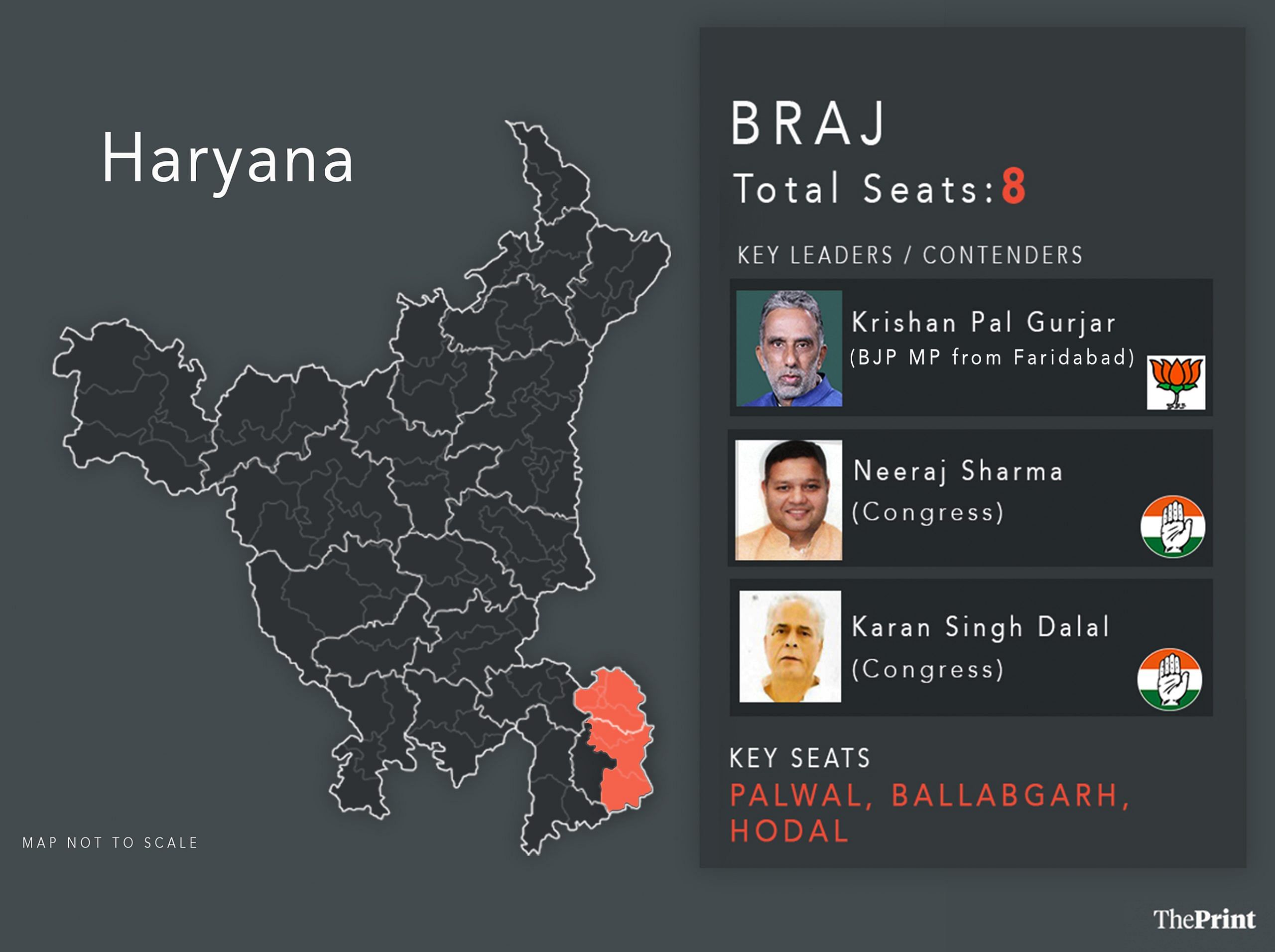
Another key belt is Braj which has a cultural affinity with the Mathura area of Uttar Pradesh.
Union Minister of State Krishan Pal Gurjar and former MLA Karan Singh Dalal come from the Braj region which consists of parts of Palwal and Nuh districts, and Faridabad’s Ballabgarh area.
The Congress’s Karan Singh Dalal from Palwal and Neeraj Sharma from Faridabad NIT are prominent faces contesting the polls.
Community issues in this belt with eight assembly seats are decided by the Pals much like the Jats have khaps in the Deswali region.
Residents still carry out Braj Mandal Jalabhishek Yatra during the Sawan month of the Hindi calendar. It was during one yatra that Nuh witnessed violence last year.
Smaller regions
Besides these, there are smaller regions like Panchal in northern Haryana, covering areas like Ambala, Yamunanagar and parts of Kurukshetra and Kaithal; the Nali region between the Ghaggar-Hakra River and the Yamuna, encompassing parts of districts like Sirsa, Fatehabad and Hisar, where there’s a mixture of Haryanvi and Punjabi dialects; and the Shivalik region comprising Panchkula district and parts of Ambala and Yamunanagar districts.
Prominent faces from the Shivalik region include former chief minister Bhajan Lal’s son Chander Mohan from the Congress, Speaker Gian Chand Gupta of the BJP from Panchkula and Rajya Sabha MP Kartikeya Sharma’s mother, the BJP’s Shakti Rani Sharma from Kalka.
(Edited by Sugita Katyal)













